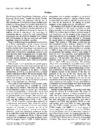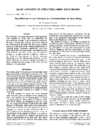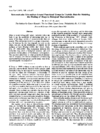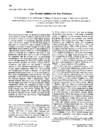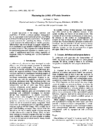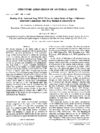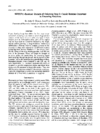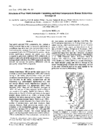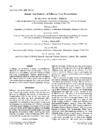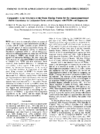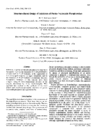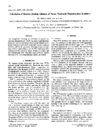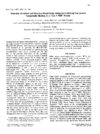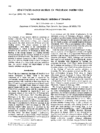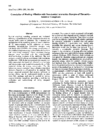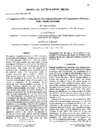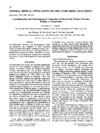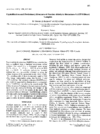issue contents
July 1995 issue

Cover illustration: Active site of purine nucleoside phosphorylase with the electrostatic potential surface and dipole of guanine. Rendered with Ribbons++ and SPARTAN.
research papers
Correlation between small-molecule X-ray structures and biological systems.
An overview is given of the directionality of selected intermolecular interactions. These data are obtained from crystal structure determinations and can be used for modeling drug-macromolecule interactions.
Crystallogtaphic, inhibition and electrostatic studies with carbexygeptidase A present further details about the role of the Zn atom and other active-site groups in substrate binding and catalysis of zinc proteinases. These details combined with model compound studies suggest a rational approach for specific inhibitor design for this enzyme family which is based on zinc binding and its particular coordination preferences.
A detailed description of software for the exploitation of known structural information in the modeling of protein structures is presented.
Several glucose analogue inhibitors of glycogen phosphorylase have been studied in crystallographic, kinetic and 3D QSAR experiments. Comparison of the N-methylacetylglucopyranosyl amine with the analogous C-methylamide derivative showed a fivetold improvement in Ki and a 200-fold improvement compared with glucose.
High-resolution crystal structures of complexes of peliovirus and rhinovirus with the antiviral compound disoxaril (WIN5l7ll) are compared.
PDB reference: 1piv
Capsid-binding drugs that inhibit the first stage in picornaviral uncoating were used to select drug-resistant mutants of peliovirus type 3. Such mutants focus attention on parts of the capsid liable to have important functions in viral uncoating.
The structures of four novel capsid-binding antipicornaviral compounds are determined in human rhinovirus 14. These structures are used to provide a better understanding of drug-design issues within the capsid-binding pocket of rhinoviruses.
Aromatic inhibitors of influenza virus neuraminidase were designed using X-ray crystal structures. The success of this iterative strategy could be applied in other drug-design targets.
The structure of FKBPl2 is reported for the first time in its unliganded form, and in complex with 18 inhibitors. Analysis of these structures suggests that FKBP12 is locally flexible.
Simple, non-macrocyclic inhibitors bind FKBPl2 as tightly as FK506 and potently inhibit the peptidyl prolyl isomerase activity of that enzyme. The structure of one of these in complex with FKBPI2 is presented.
Structure-based drug-design techniques have been utilized to design and synthesize novel and potent inhibitors of purine nucleoside phosphorylase.
Experimentally measured binding constants of inhibitors to purine nucleoside phosphorylase compared with calculations using X-PLOR, DelPhi and SoftDock give mixed results.
From the crystal structure of a class I MHC protein, non-natural peptides have been successfully designed as high-affinity ligands for the target protein.
PDB reference: 1rol
The structures of two mimetic inhibitor complexes of thrombin have been determined. One is based on a conformationally restricted bicyclic β-twin while the other mimics two different active-site binding modes.
Evaluation of several empirical modeling protocols for estimating the binding between thrombin and 35 inhibitors showed an optimal predictive value when during the energy minimization the enzyme was constrained and electrostatics were scaled down.
Trypanothione reductase is a target for chemotherapy of trypanosomal infection. A detailed comparison of two crystal forms provides a consensus template for drug design.
The structure of the hologlyceraldehyde 3-phosphate dehydrogenase was solved at 3.2 Å resolution from Laue data by a combination of molecular replacement, density modification and refmement by simulated annealing including non-crystallographic symmetry constraints and restraints. The three-dimensional structure of this enzyme is described and compared to the model of the enzyme from Bacillus stearothermophilus.
Crystallographic structure and thermodynamic binding parameters are compared for three structural classes of streptavidin ligand including d-biotin, 2-[(4'-hydroxyphenyl)-azo] benzoate and the peptide NH2 -Phe-Ser-His-Pro-Gln-Asn-Thr-COOH. Descriptions of these structural and thermodynamic observations emphasize the diversity of potential strategies for improving ligand affinity.
A theoretical study was performed on the structure of both the native and inhibited metalloproteinase Ht-d solved at 2.0 Å resolution. The study suggests the structural link between Ht-d and mammalian metalloproteinases, contributing to the understanding of the mechanism of natural and synthetic inhibitors binding to metalloproteinases.
PDB reference: 1htd
In the crystal structure of porcine aldehyde reductase-NADPH binary complex NADPH is held in place by a loop. A conformational change is necessary for the association and dissociation of NADPH.


 journal menu
journal menu









